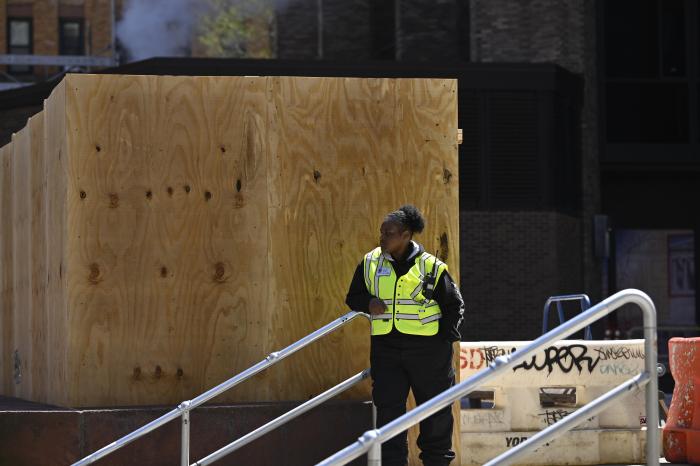By Jyoti Thottam
Certain images tell the story of Queens' school overcrowding crisis: closets turned into classrooms, playgrounds gobbled up by annexes, lunch periods pushed back into breakfast time.
But images repeated often enough may lose their power to shock. To understand school overcrowding, an issue that has loomed over educators in Queens for two decades, one may have to look a bit deeper.
The Times/Ledger begins this week an in-depth look at the past, present and future of school overcrowding. The stories in this series will explore how Queens schools reached their current crisis, how crowding affects the quality of education and how parents, educators and policy makers are trying to find a solution.
In its simplest equation, too few classroom seats plus too many students equals school overcrowding. But there are different ways of expressing what overcrowding means.
The two most commonly used measures of crowding are capacity utilization and seats. The Board of Education estimates that every district in Queens will be operating above capacity by 2007, meaning the number of students will exceed the number of classroom seats in the school building.
Using this measure, District 24 in western Queens ranks as the most overcrowded in the city and is projected to reach 170 percent of capacity by 2007 if no new schools are built. At the other end of the spectrum in the borough is District 25 in northeastern Queens, which is projected at 116 percent in seven years.
To make up that shortfall, overcrowded schools use a variety of stopgap measures, such as erecting temporary buildings, converting non-classroom space into classrooms and leasing space in other buildings. In some schools the class day is longer, allowing the schools to stagger students' classes and accommodate more students in a building.
This additional space allows the schools to function beyond their capacity by providing “seats,” the hard currency of school construction.
The shortage of seats in Queens that politicians and educators talk about – 22,000 seats over the next seven years in the best case scenario – will be met by not only new school buildings but also a range of temporary measures that could be as unpalatable as losing a playground for a transportable classroom unit or lengthening the class day.
When using the number of seats as the measure of overcrowding, the magnitude of the problem becomes a bit clearer: District 24 will have to fill a shortfall of 18,701 seats by 2007 using whatever methods are available. District 27 is not far behind, needing 15,103 seats, while District 25 faces a shortfall of 3,698 seats.
Capacity utilization and total seats are the two numbers used most often by the Board of Education, but education advocates focus on another – class size. Not surprisingly, the districts with the most overutilized schools also have the largest class sizes.
In Queens, three districts had average class sizes larger than 26 children per teacher at the high end of the range in the borough: Districts 24 and 27 in western Queens and District 29 in southeastern Queens. These same three districts were operating at, respectively, 119, 110 and 113 percent of capacity in 1997. By comparison, the state average is 21 students per class in kindergarten and 23 for grades 1 to 6.
On the other side of the school crowding balance sheet is the ever-increasing supply of students. But the population of Queens as a whole has remained fairly constant throughout the last decade, with an overall increase in population of just 2.4 percent between 1990 and 1998, according to the U.S. Census Bureau.
This increase is the net result of two trends moving in the opposite direction: people moving out of Queens exceeding immigrants moving in by nearly 64,000 between 1990 and 1998. But the birth rate exceeded the death rate by more than 118,000 for that period, and most of those births were to immigrant households, who tend to be younger and in their child-bearing years.
What has changed is the age of this population. The school-age population of Queens increased five times faster than the general population, jumping 11.6 percent between 1990 and 1998, according to the U.S. Census Bureau. That increase has fueled an influx of students into the public schools: enrollment in Queens' public schools increased by 35 percent between 1985 and 1997, according to the Board of Education.
The rapid growth in the student population came as no surprise to the Board of Education, which commissioned a study in 1990 on the future of school enrollment. The study concluded that the city would experience a rapid increase in the student population in the 1990s, and that most of that growth would occur in Queens.
This projection, which proved to be true, was a reversal of the prior trend in the student population. School enrollment in New York City steadily declined throughout the 1970s and reached a low point of 920,000 students in 1982. Enrollment remained fairly steady during the rest of the 1980s but began to climb in 1990.
This ambitious plan represented a break from the period following the city's 1975 fiscal crisis. Between 1975 and 1983, the overall city budget shrank by 22 percent and more than 15,000 teachers and other school aides were laid off.
During this period, even as total enrollment declined, average class size rose by 25 percent because of the lack of teachers. Capital funds for schools were also frozen, and parts of Queens began to see overcrowded classrooms as early as 1976.
The 1993 capital plan would have addressed some of the rapid student enrollment growth that was already happening in Queens, but the city agreed to fund only $3.4 billion – or less than half of the proposed amount –































